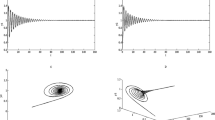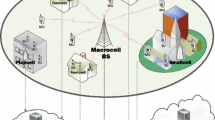Abstract
The work is devoted to the construction and justification of the mathematical model of the competitive behaviour of cellular communication in the form of a system of nonlinear differential equations with delay time describing the dynamics of changes in the subscriber base of cellular operators competing for shared resources.
You have full access to this open access chapter, Download conference paper PDF
Similar content being viewed by others
Keywords
- Mathematical model
- Differential equations with lag
- Optimal control
- Identification of parameters
- Principal of pontryagins maximum
Competition is essential and most important in many actual processes. Mathematical modeling is a basic way to control the agents of competition. It allows to consider the different factors influencing their interaction dynamics. Actual agent competitive behavior modeling widely uses nonlinear differential equations with retarded argument which provides more complex structure dynamic models. That is why the development of bundled software based on efficient numerical methods aimed to solve nonlinear dynamics and control problems is an essential scientific task.
There are many works on nonlinear object control. But the task to determine optimal control has not been studied for enterprise development dynamic models with a phase variable lag. The urgent objective here is to find efficient algorithms of optimal control solutions in such systems as well as to develop the adequate software. Thus the management of enterprises will be provided with Decision Support Systems aimed to develop the communication service tariff policy.
There are three cellular operators in Russia. They are: MTS, Beeline and Megafon. There are also many smaller cellular enterprises. The 2004–2010 data of user base and tariff policy have been used for our model parameter identification. The research has been carried out based on the interaction of two economic agents. We divide all the operators into two unequal groups. The first economic agent (EA1) is one of the leading cellular enterprises. The other economic agent (EA2) includes all the rival enterprises summing the number of their users in the actual market.
Assume with no competition the number of customers for each economic agent grows exponentially, with increment rate \(\varepsilon _i\). Considering the saturation effect in the cellular service market as well as competition we describe the development dynamics for the two agents user base through the system of differential equations
The time lag is to be considered in interaction of economic agents as the time difference between the moment of managerial decision and the actual changes of market situation. The user base general dynamics can be expressed through the system of nonlinear differential equations with retarded argument
To model the cellular enterprise behavior control we introduce an intensity brackets \(u_i(t), i=1,2\) thus describing the average minute cost at moment t and satisfying the restriction
Thus the controllable model of two economic agent interaction in the conditions of competition for cellular service users can be described through Lotka-Volterra logistic model with retarded argument
There is a lower boundary of user base volume providing normal operation, as well as an upper boundary determined by the network performance specifications. The above are presented through phase variable restrictions
The number of cellular Operator I users at the initial interval \([-\tau ,0]\) is determined by the functions
Parameter identification for the system of differential equations is an important procedure in modeling and solution of optimal control problem. Based on the method of model setting to the experimentally obtained data, the approach to the simultaneous identification of system parameters and the value of the lag is the subject of our research. The parameters are set to minimize the functionals characterizing the quality of model settings.
This approach implies multiple monitoring of the dynamic process, considerably exceeding the dimensionality of the system.
In course of economic agent interaction a company may face different managerial goals expressed in corresponding quality criteria (7) (9). According to the first economic agents (EA1) development priorities we find the optimal control solution for each objective functional:
-
1.
user base growth
$$\begin{aligned} J_1(u_1)=\int \limits _0 ^T b_1x_1(t)dt \rightarrow \max ; \end{aligned}$$(7) -
2.
reaching the aimed user base
$$\begin{aligned} J_2(u_1)=b_2\left( x_1(T)-M\right) ^2 \rightarrow \min , \end{aligned}$$(8)where \(M\) – planning value of the subscriber base EA1;
-
3.
EA1 income growth
$$\begin{aligned} J_3(u_1)=\int \limits _0 ^T b_3x_1(t)u_1(t)dt \rightarrow \max . \end{aligned}$$(9)
The problems set above can be classified as optimal control fixed lag problems. To solve them, in this research we have used Pontryagin’s maximum principle for fixed-lag systems. We suggested that the cost value of one EA2 minute is fixed and can be evaluated by the previous tariff policy dynamics.
The optimal control problem is characterized by: Nonlinearity of the differential equation system describing the user base dynamics for the two economical agents; constant lag in the controlled systems state vector. Considering the above features we obtained the optimality conditions. We based the solution numerical algorithm on that. The control restrictions in the problem have been considered due to the gradient projection method, given an arbitrary choice of control initial approximation.
The use of one numerical method is not always enough to find the solution for the optimal control problem with the required precision. That is why different algorithms can be used in the process of solution. One of the approximate methods used to solve nonlinear object optimal control problems was suggested by L.I. Shatrovsky. Its based on linearization of a set non-linear system and further iterative procedure solving a linear problem at each step so approximating the initial task. As a result we get a control close enough to the optimal. To improve the calculation reliability solving the optimal control problems we suggest a combined method. It implies the choice of Shatrovsky method allowable control as the initial approximation in the gradient projection method. This approach to the choice of control initial approximation allows to avoid the functional in the local extremum.
Our methods and algorithms have served as the basis for bundled software aimed at the search of numerical solution for an optimal control problem, two economical agents competing for communication users. This software finds the index values for the parameters and lag by the user base statistics data and the previous tariff policy. It also proves helpful for communication enterprise managerial strategies according to development priorities.
Computing experiments have been carried out to examine the efficiency of the suggested models and algorithms for the major communication operators in the Russian market.
The conclusion has been made that the introduction of control and lag in the cellular communication enterprise model improves the values of the objective functional which substantiates the choice of the controlled system (9)
The established relation is efficient approximating the experimental data, the difference between calculation data and experimental data being 6,5\(\%\). User base and tariff policy updates are followed up by parameter identification which enhances modelling precision.
Based on the gradient projection method and combined method we determine the optimal decision for each objective functional as well as find the corresponding values.
Comparative analysis shows that the control achieved with the use of the suggested combined method is more efficient to increase the EA1 user base.
The EA1 user base values have been calculated for each objective functional at the end of 30 month forecasting interval. A significant growth of EA1 user base by this moment proves the efficiency of suggested combined method for solution of cellular communication enterprise interaction.

Our bundled software has been used by Orenburg branch of ROSTELECOM controlling their tariff policy.
The developed models and algorithms can be modified for any economical agents practical problems in their competitive activity, such as web-site user base or radio listener base control or TV channel rating etc.
References
Andreeva, E.A., Tciruleva, V.A.: Calculus Of Variations and Optimization Methods, p. 575. Tver state University, Orenburg, Tver (2004)
Bolodurina, I.P.: Differential equations with delay argument and applications. Orenburg. st. un-ty, 101 p. (2006)
Bolodurina, I.P., Ogurtsova, T.A.: Managing the price for services of the enterprises of the telecommunications industry. Prob. Manage. N3, 30–35 (2011)
Koblov, A.I., Shiryaev, V.I.: Optimal control of the behaviour of firms on the market of cellular communication. Theory Syst. N5, 157–165 (2008)
Prasolov, A.V.: Dynamic models with delay and applications in Economics and engineering. SPb.: Fallow deer, 192 p. (2010)
Author information
Authors and Affiliations
Corresponding author
Editor information
Editors and Affiliations
Rights and permissions
Copyright information
© 2014 IFIP International Federation for Information Processing
About this paper
Cite this paper
Bolodurina, I., Ogurtsova, T. (2014). The Optimal Control of Cellular Communication Enterprise Development in Competitive Activity. In: Pötzsche, C., Heuberger, C., Kaltenbacher, B., Rendl, F. (eds) System Modeling and Optimization. CSMO 2013. IFIP Advances in Information and Communication Technology, vol 443. Springer, Berlin, Heidelberg. https://doi.org/10.1007/978-3-662-45504-3_4
Download citation
DOI: https://doi.org/10.1007/978-3-662-45504-3_4
Published:
Publisher Name: Springer, Berlin, Heidelberg
Print ISBN: 978-3-662-45503-6
Online ISBN: 978-3-662-45504-3
eBook Packages: Computer ScienceComputer Science (R0)




